Chemical Substance Management
(Stance and Approach)
Minimizing Environmental Impact through Proper Control and Reduction of Chemical Substance Emissions
While the chemical substances that SEKISUI CHEMICAL Group is involved in make people's lives more convenient, they can also have harmful effects on the environment and human health. Therefore, we believe that it is an important corporate responsibility to properly manage chemical substances and to consider product safety, occupational safety and health, and environmental impact.
In addition to operating the Product Assessment System for Environmental Impact*1 and the Green Procurement System*2, the Group has set and worked toward its own targets for reducing emissions and the transfer of chemical substances. Moreover, in order to respond to legal and other regulatory revisions, we periodically review the chemical substances that require regulation.
- Product Assessment System for Environmental Impact: A system for assessing the environmental impact of products at all stages from raw material procurement through manufacture, use, disposal, and transportation.
- Green Procurement System: A system which prioritizes lower levels of environmental impact when procuring raw materials, parts, etc.
- Out_E86
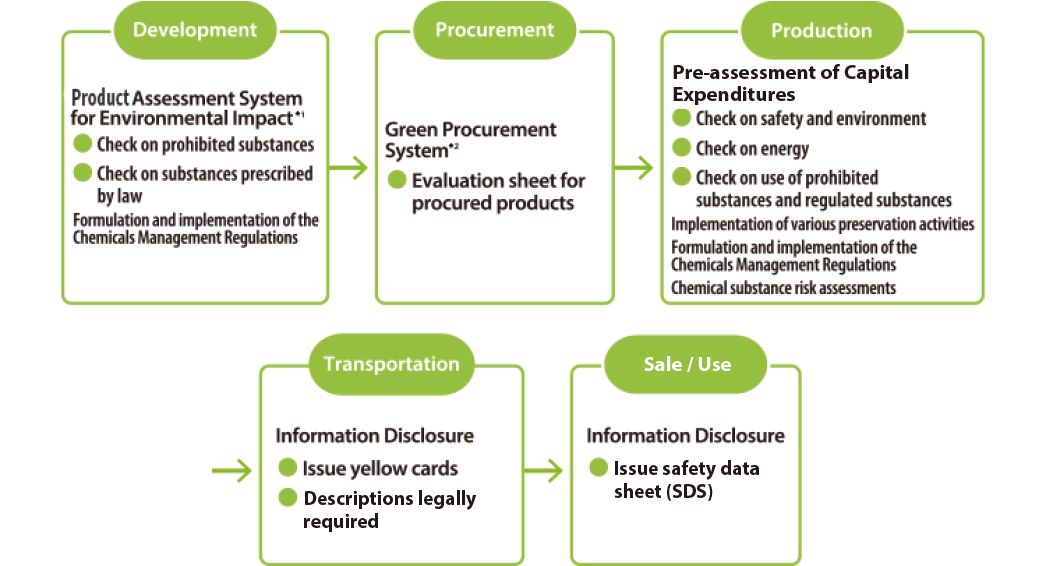
Promotion System for Chemical Substance Management Issues
In similar fashion to other statutory and regulatory requirements, and as far as the management of chemical substances is concerned, steps are taken to consider and implement appropriate countermeasures under the supervision of the Board of Directors. The Group’s supervisory and executive systems are based on the Environmental Management Promotion System for matters related to environmental issues. (For details see here)
Controlling VOC Emissions
In FY2023, VOC emissions in Japan increased 83.7% compared with FY2022.
- Note: However, due to revision to the applicable law, the number of substances subject to aggregation has been drastically changed since FY2023.
Preventing Air and Water Pollution
SEKISUI CHEMICAL Group complies with the values stipulated in laws and ordinances for equipment related to exhaust gases and water drainage.
Soil Contamination Countermeasures
We conduct voluntary assessments of soil contamination at all of our production sites. Where contamination is found, we take measures to purify and prevent further contamination, and report the results to the government. In addition, we continuously monitor groundwater to confirm that contamination has not spread.
When land is sold due to the closure of a production site, we undertake steps in accordance with the law. In FY2023, no new measures were required.
Disposal and Storage of Devices Containing PCBs and Management of Equipment That Uses Fluorocarbons
We are progressively disposing of transformers and capacitors that contain PCBs, starting with business sites that are now able to accept them at PCB treatment facilities.
Machines and equipment that contain PCBs in storage are strictly managed through a variety of means. This includes the locking of storage facilities and periodic inspections.
Steps are also being taken to enhance awareness toward mandatory requirements regarding equipment that uses fluorocarbons in accordance with Japan’s Act on Rational Use and Proper Management of Fluorocarbons (Freon Emission Control Act) and to ensure thoroughgoing management including periodic inspection.
-
Note 1:From FY2019, Medical Business results have been tabulated on a stand-alone basis owing to its separation from the HPP Company. The presentation of Corporate Headquarters results has been reclassified as Other.
-
Note 2:In line with a change in the control of certain businesses in the UIEP and HPP companies implemented from October 2022, the data for FY2022 of both companies is collated as if the change in control had been initiated from the beginning of FY2022.
-
Note 3:Figures are tabulated based on the review of designated chemicals under the PRTR Law, which was revised in FY2023. However, data prior to FY2022 has not been retroactively revised.
- Out_E80
- Out_E81
-
Amount of Chemical Substance Emission and Transfer (PRTR Law) / Japan
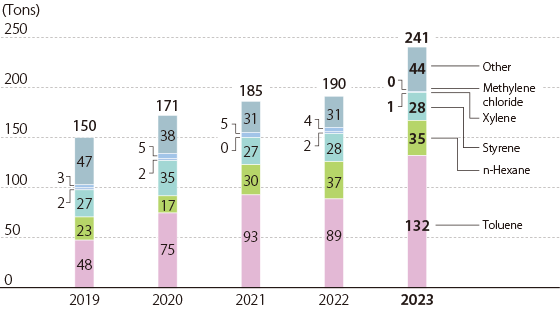
-
Note:Despite a change in the substances covered following revisions to the law in 2023, past data has not been retroactively adjusted.
Index Calculation Method Amount of Emissions / Transfer of Chemical Substances Amount of emissions / transfer of chemical substances subject to regulation by the PRTR Law: Amount of emissions = Amount of emissions into the air + Amount of emissions into public waters + Amount of emissions into the soil on-site + Amount disposed by landfill on-site
Transfer volume = Amount transferred to sewers + Amount transferred as waste material
Scope: Covers production sites and research facilities in Japan -
-
Discharge of Volatile Organic Compounds (VOCs) into the Atmosphere / Japan
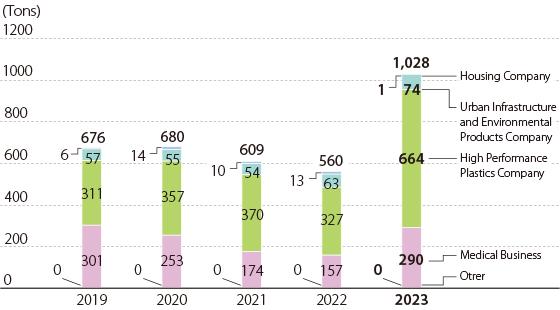
-
Note:Despite a change in the substances covered following revisions to the law in 2023, past data has not been retroactively adjusted.
Index Calculation Method VOC Emissions Amount of emissions into the atmosphere of volatile organic compounds (VOC) among the substances subject to regulation by the PRTR Law and Japan Chemical Industry Association -
- Out_E82
- Out_E83
-
NOx Emissions / Japan
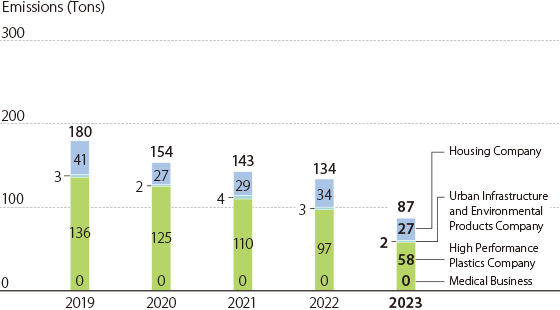
Index Calculation Method NOx Emissions NOx emissions =Σ(Amount of exhaust gas airflow per year × NOx concentration × 46 / 22.4) -
SOx Emissions / Japan
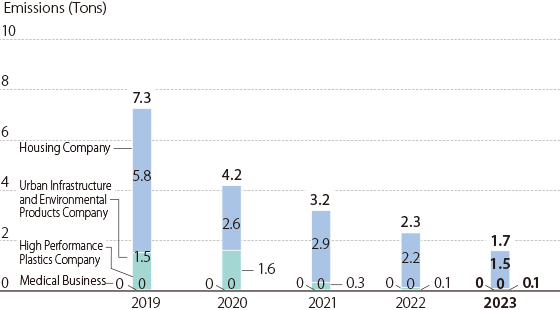
Index Calculation Method SOx Emissions SOx emissions =Σ(amount of SOx per year × 64 / 22.4)
- Out_E84
-
Soot and Dust Emissions / Japan
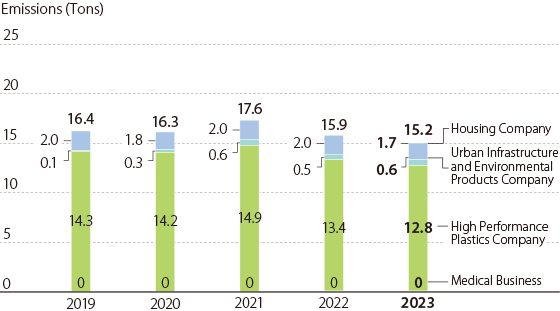
Index Calculation Method Soot and Dust Emissions Soot and Dust emissions =Σ(amount of exhaust gas airflow per year × soot concentration)
